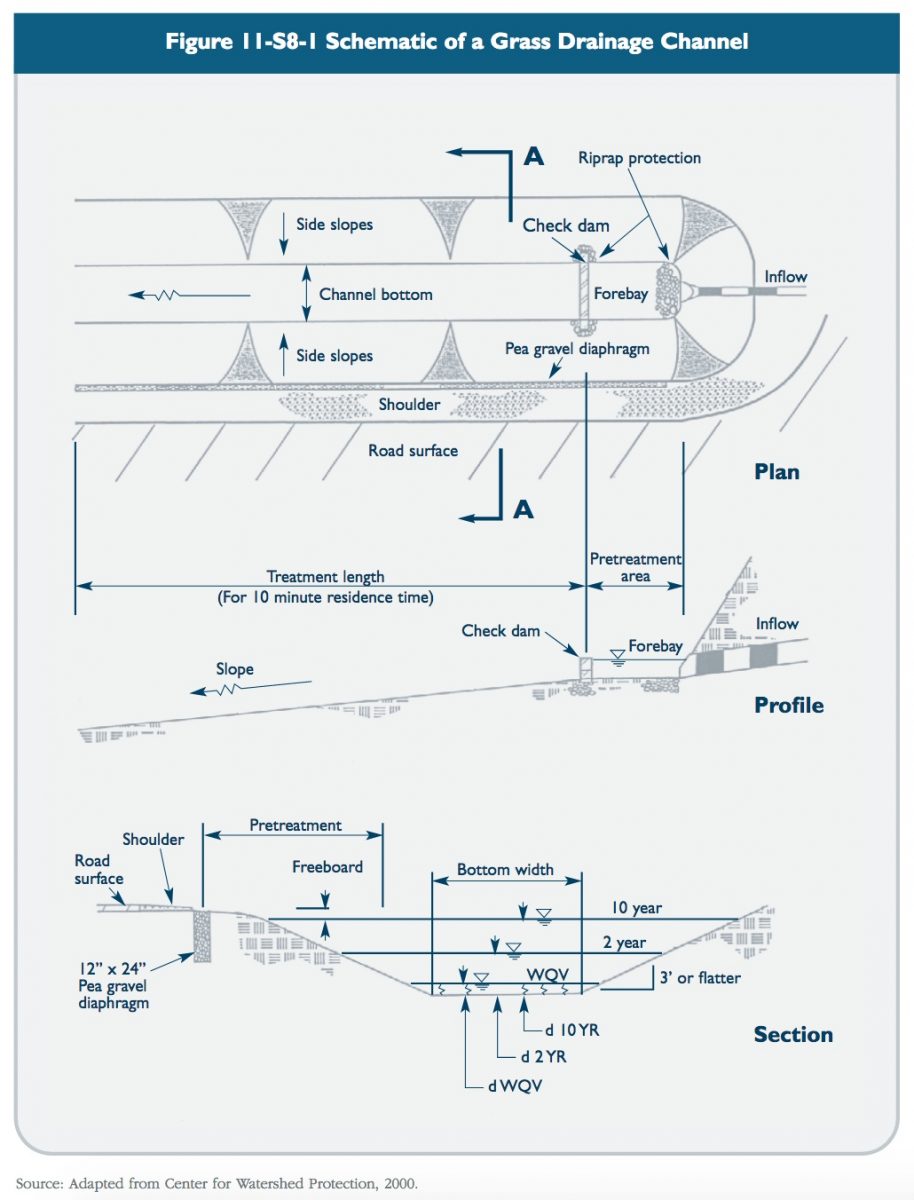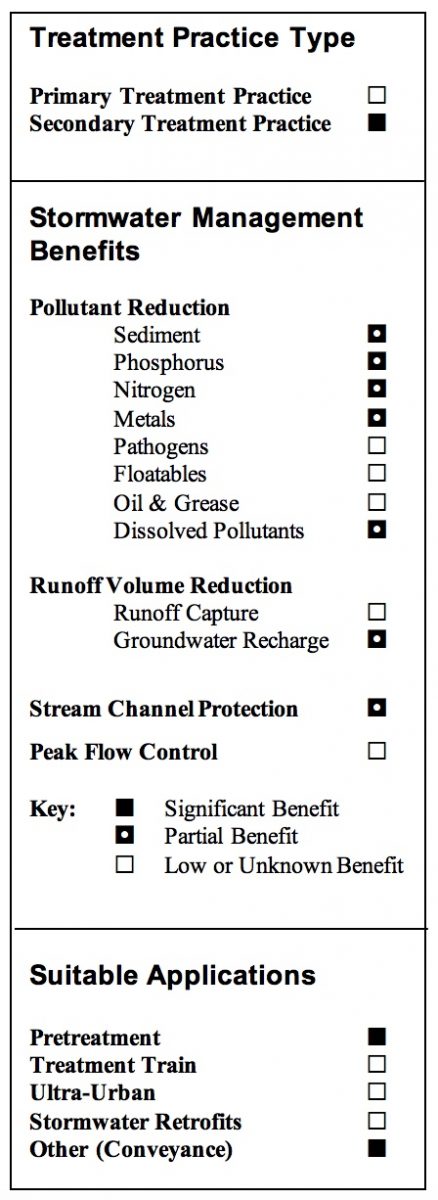Description
Grass drainage channels are traditional vegetated open channels designed for conveyance rather than water quality treatment. Drainage channels provide limited pollutant removal through filtration by grass or other vegetation, sedimentation, biological activity in the grass/soil media, as well as limited infiltration if underlying soils are pervious. However, their primary function is to provide non-erosive conveyance, typically up to the 10-year frequency design flow. Grass drainage channels are typically trapezoidal, triangular, or parabolic in shape and are designed based on peak flow rate rather than a water quality volume approach.
Drainage channels are commonly incorporated into highway and road drainage systems, but can also be used in place of traditional curb and gutter drainage systems in residential and commercial areas to enhance pollutant removal and to provide limited groundwater recharge and runoff volume reduction. Figure 11-S8-1 depicts a schematic of a typical grass drainage channel.

Reasons for Limited Use
* Provide limited pollutant removal.
* Require more maintenance than traditional curb and gutter drainage systems.
* May be impractical in areas with very flat grades, steep topography, or poorly drained soils (Metropolitan Council, 2001).
* Large area requirements for highly impervious sites.
Suitable Applications
* For runoff conveyance.
* As pretreatment in conjunction with other stormwater management practices.
* Can replace traditional curb and gutter drainage system for new development or stormwater retrofits.
* Linear nature makes drainage channels ideal for highway and residential road runoff, as well as industrial parks and institutional areas.
Design Considerations
Specific design criteria and procedures for grass drainage channels are beyond the scope of this manual. Grass drainage channels should be designed in accordance with established open channel flow principles and accepted stormwater drainage design practice, as described in the following recommended references:
* Connecticut Department of Transportation (ConnDOT), Connecticut Department of Transportation Drainage Manual, October 2000.
* Connecticut Council on Soil and Water Conservation and the Connecticut Department of Environmental Protection, 2001 Connecticut Guidelines for Soil Erosion and Sediment Control, DEP Bulletin 34, 2001 (draft).
* USDA Soil Conservation Service, National Engineering Field Manual, Natural Resources Conservation Service, Washington, D.C., 1988.
Some general design considerations include:
* For enhanced water quality performance, provide sufficient channel length to retain the water quality volume in the system for at least 10 minutes (using a check dam if necessary) and limit the water quality peak flow to 1 foot per second and a depth of no greater than 4 inches (i.e., the height of the grass). However, most of the pollutant reduction in grass drainage channels has been shown to occur in the first 65 feet of the channel (Walsh et al., 1997). Longer channels designed solely for water quality improvement may not be cost effective.
* For enhanced pollutant removal, design the channel side slopes to serve as vegetated filter strips by accepting sheet flow runoff. Pollutant removal that occurs across the channel side slopes (i.e., vegetated filter strip) can exceed the pollutant removal that occurs down the longitudinal length of the channel, particularly for highway medians with side slopes of 25 feet or longer (Walsh et al., 1997).
* Design the channel to ensure non-erosive velocities for the soil type and vegetation condition of the channel (see Connecticut Guidelines for Soil Erosion and Sediment Control for maximum permissible velocities).
* Design the channel with sufficient capacity and conveyance for the 10-year frequency storm event.
* Native grasses are preferred for enhanced biodiversity, wildlife habitat, and drought tolerance. Grass species should be sod-forming, resistant to frequent inundation, rigid and upright in high flows, and salt tolerant if located along a roadway. Wetland species may be used for the bottom of a wet swale. The following grasses perform well in an open channel environment:
- Red Fescue (Festuca rubra)
- Tall Fescue (Festuca arundinacea)
- Redtop (Agrostis alba)
- Smooth Bromegrass (Bromus inermis)
- Reed Canarygrass (Phalaris arundinacea L.).
References
Claytor, R.A. and T.R. Schueler. 1996. Design of Stormwater Filtering Systems. Center for Watershed Protection. Silver Spring, Maryland.
Connecticut Department of Transportation (DOT). 2000. Connecticut Department of Transportation Drainage Manual.
Connecticut Council on Soil and Water Conservation and the Connecticut Department of Environmental Protection. 2002. 2001 Connecticut Guidelines for Soil Erosion and Sediment Control, DEP Bulletin 34.
Metropolitan Council. 2001. Minnesota Urban Small Sites BMP Manual: Stormwater Best Management Practices for Cold Climates. Prepared by Barr Engineering Company. St. Paul, Minnesota.
USDA Soil Conservation Service. 1988. National Engineering Field Manual. Natural Resources Conservation Service. Washington, D.C.
Walsh, P. M., Barrett, M.E., Malina, J.F., and R. Charbeneau. 1997. Use of Vegetative Controls for Treatment of Highway Runoff. Center for Research in Water Resources. Bureau of Engineering Research. University of Texas at Austin. Austin, TX.
